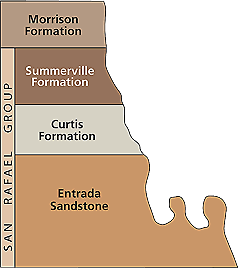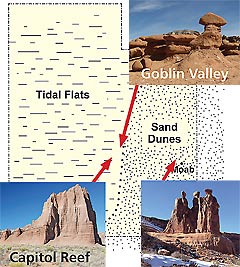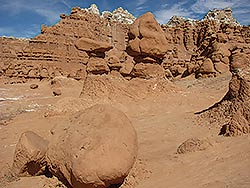GEOLOGY HAPPENINGS August 2020 |
||||||
| Goblin Valley State Park: Earthy and Strangeby Allyson Mathis | ||||||
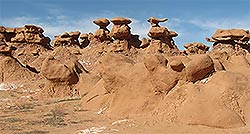 By its inherent nature, Goblin Valley provides an opportunity to explore the definition of two words: one a common word in the English language (strange) and the other, a term of art in geology (earthy). By its inherent nature, Goblin Valley provides an opportunity to explore the definition of two words: one a common word in the English language (strange) and the other, a term of art in geology (earthy).The word “strange” means unusual or surprising or not previously visited, seen or encountered. It is derived from the Latin extraneus, meaning external or foreign, and which is the same root as the words estrange and extraneous. By any definition Goblin Valley is strange, even to those fluent in the language of the landscapes of southern Utah. Goblin Valley is markedly different than the cliffs, canyons, and mesas found in most of the rest of the region. The Valley of the Goblins is characterized by barren ground, and by whimsical and fanciful rock features on a relatively intimate scale.
While there are only four rock layers (formations) exposed in Goblin Valley State Park, the four layers are also found near Moab. From oldest to youngest, they are the Entrada Sandstone, the Curtis Formation, the Summerville Formation, and the Morrison Formation. But they each look different in Goblin Valley than they do near Moab because of facies changes in them. A facies is geographically-restricted part of a rock layer that is usually made of a different rock type or contains different fossils than other beds deposited at the same time in an adjacent area. Not every formation contains facies, but those that do were usually deposited in environments that changed from one region to another. For example, in eastern Utah, the Entrada Sandstone was deposited in a coastal sand dunefield and in the central part of the state, it was formed in a tidal flat environment. Sometimes a subdivision (called a member) of a rock layer is defined to incorporate a unique facies within it. Good examples include the eolian (wind-deposited) Slick Rock Member of the Entrada in Arches National Park, or the Moab Member (or “Tongue”) of the Curtis, also found near Moab. 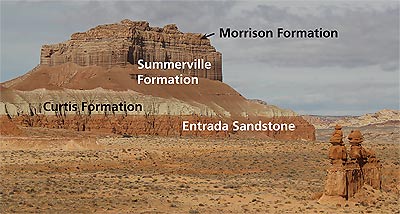 The Entrada Sandstone is the main rock layer found in Goblin Valley, and its earthy characteristics there are largely responsible for the development of the goblins, or “stone babies.” Goblin Valley is situated near the transition between the dunefield and the tidal flats environments, and the Entrada in Goblin Valley contains influences of both environments. As a result, it looks drastically different than the slickrock-forming Entrada in Arches, nor the thinly-laminated Entrada found in the northern part of Capitol Reef National Park. But slight variations between the layers of the Entrada Sandstone in Goblin Valley have different resistances to weathering and erosion, which in turn leads to the development of the undulating and eccentric pinnacles known as goblins (or more
A visit to Goblin Valley is a geological treat, one that will hopefully lead to a greater appreciation of the earth, and for the word strange. Goblin Valley may be strange, but it is also wonderful. The state park is located approximately 100 miles south west of Moab. To learn more, please visit stateparks.utah.gov/parks/goblin-valley. Special thanks to Grant Willis and Doug Sprinkel (emeritus) of the Utah Geological Survey.
|
||||||
|
